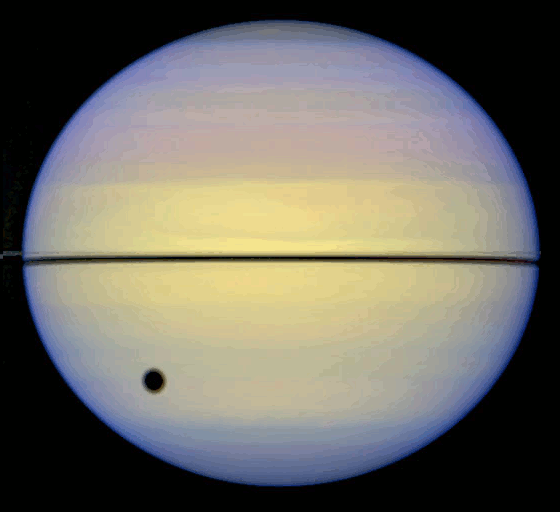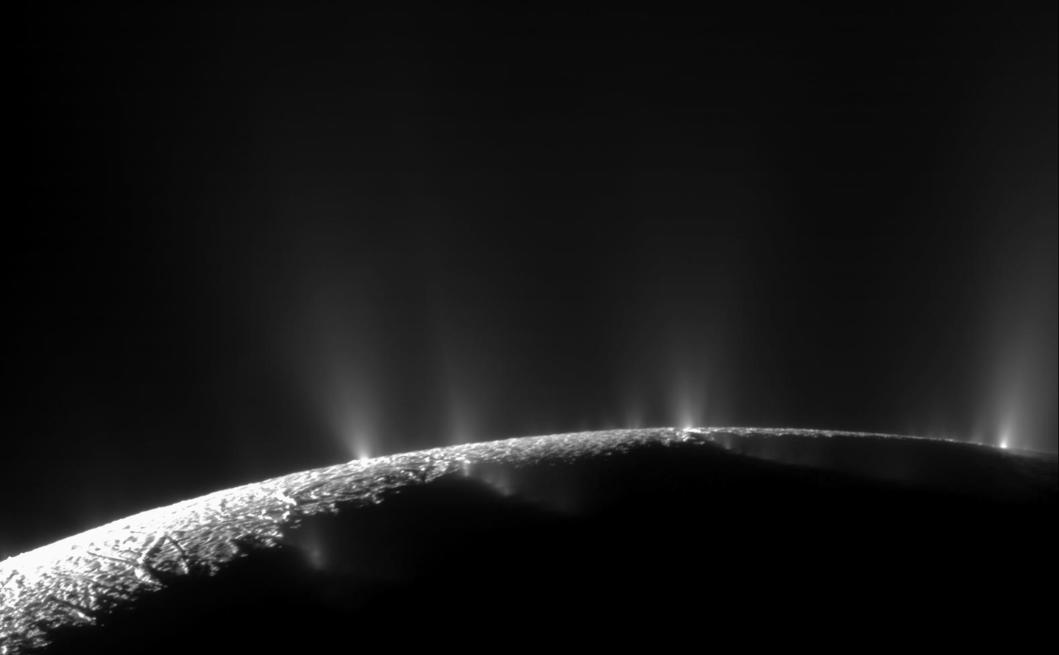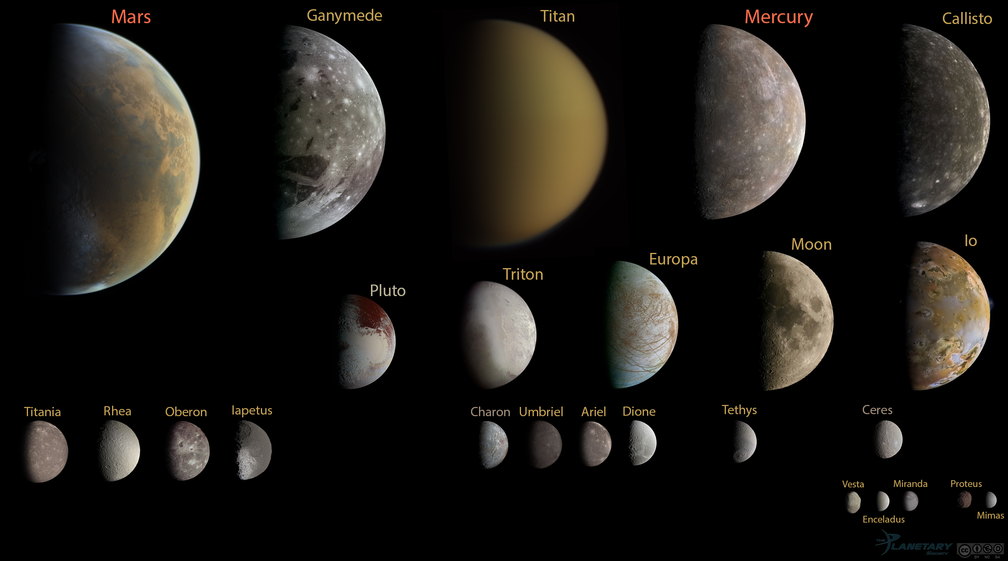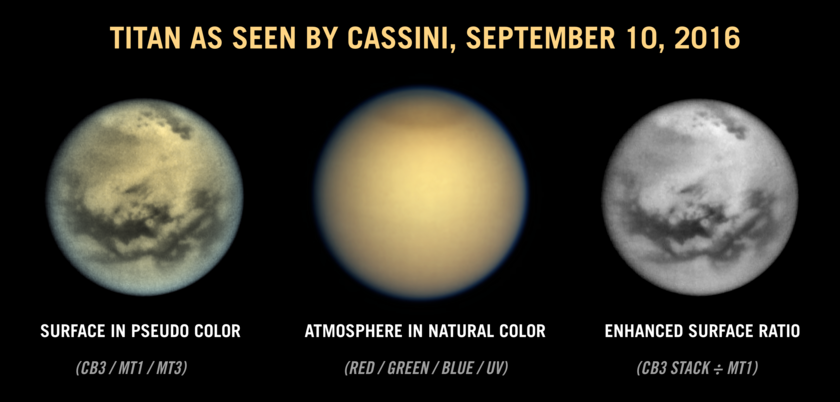 Copyright © Michael Richmond.
This work is licensed under a Creative Commons License.
Copyright © Michael Richmond.
This work is licensed under a Creative Commons License.
Saturn, its rings, and Titan
Yes, yes, it's the planet with the big, bright rings.
We'll discuss the rings in a bit, but
what about the planet itself?
In some ways, Saturn is very similar to Jupiter --
a little brother.
Q: Can you name 4 features of Jupiter?
- Jupiter is big -- and Saturn is also big.
-
Just less big.

Sources for these images can be found at
http://spiff.rit.edu/classes/resceu/ss_planets/earth_moon_lineup.html
Despite being almost as large as Jupiter,
Saturn has much less mass:
not even one third that of Jupiter.
Jupiter 1898 x 1024 kg = 318 Earth masses
Saturn 568 x 1024 kg = 95 Earth masses
The reason for this big difference in mass lies in the interior
structure of the two planets.
It appears that Saturn has a smaller layer of dense metallic hydrogen
than Jupiter;
therefore, a larger fraction of its volume is filled with
low-density gases.

Image courtesy of
NASA/Lunar and Planetary Institute
- Jupiter rotates fast. Saturn rotates almost as fast
-
The length of a Jovian day is 9.9 hours. Saturn's day is slightly
longer, about 10.7 hours.
However, since Saturn has a lower overall density
(remember that
Saturn would float in a big enough bathtub ),
its rotation causes its equator to bulge outward even
farther, relative to its polar dimension.
The picture below shows Jupiter and Saturn, scaled to have the
same apparent polar diameter. Can you see how much wider at the
equator Saturn appears to be?

Images courtesy of
(Saturn) Erich Karkoschka (University of Arizona Lunar & Planetary Lab)and NASA/ESA
and
(Jupiter) NASA, ESA, and A. Simon (Goddard Space Flight Center)
If not, perhaps a little animation might help.

Images courtesy of
(Saturn) Erich Karkoschka (University of Arizona Lunar & Planetary Lab)and NASA/ESA
and
(Jupiter) NASA, ESA, and A. Simon (Goddard Space Flight Center)
- Jupiter has a strong magnetic field. So does Saturn
-
Jupiter's field is stronger. While Jupiter's dipole magnetic
field strength is about 15 times that of the Earth,
Saturn's is only about two-thirds of the Earth.
Still, that means that charged particles
which run into the field are funneled into
the atmosphere near the poles,
just as they are on Jupiter and the Earth.

Image courtesy of
NASA/Hubble/Z. Levay and J. Clarke
Like Jupiter and the Earth, Saturn has a series of
radiation belts around it, in which energetic electrons
and protons are trapped.
In the case of Saturn,
these particles may originate
in the planet's own atmosphere, rather than from the solar wind.

Image courtesy of
NASA/JPL/Space Science Institute
So Saturn's magnetic field is weaker than Jupiter's -- does that
mean that it is less dangerous to visit its inner moons?
If you look at the figure above, you can see gaps,
or dips, in the radiation intensity of the belts
near the location of several satellites.
That's good news, right?
Well, one of those inner moons is Mimas
(aka the "Death Star" moon).

Image courtesy of
NASA/JPL/SSI
The radiation levels near its surface are ... pretty similar
to the levels near the surface of Europa.
Remember, a dose of around 1000 rad will kill a human in
just a few hours to days;
look at the
right-most column in this table of physical effects.
Listen to an analysis of the dangers of radiation on Mimas


Image courtesy of
Nordheim et al., European Planetary Science Congress 2012
These strong magnetic fields, and hence dangerous radiation levels,
are unfortunate. One of Saturn's moons which lies within these
radiation belts,
Enceladus,
shows some giant geyser-like features that suggest it may
have an ocean of liquid water beneath its surface ...
just like Europa.

Image courtesy of
NASA/JPL/Space Science Institute
Saturn has ordinary moons, of course,
but it is more famous for the millions and billions
and trillions of teeny-tiny satellites
which for its rings.

Image courtesy of
NASA/JPL-Caltech/Space Science Institute
The particles making up the rings vary in size from
smaller than a grain of sand (lots of those)
to roughly the size of a mountain (not many of those).
How do we know?
One powerful technique involves occultations,
when some source of light passes behind the rings.
The way that the rings scatter light depends in part on their
size and shape.
For example, when the Cassini spacecraft flew into the shadow of
Saturn,
light from the Sun had to pass through the rings to reach its cameras.

Image courtesy of
NASA/JPL/Space Science Institute

Image courtesy of
NASA/JPL
Another type of occultation measurement was made when Cassini's
orbit took it behind the rings, as seen from Earth.
Cassini's antenna sent a strong radio signal to telescopes
on Earth,
which measured how the signal varied as the spacecraft moved
across the ring system.
Based on those radio measurements,
scientists could determine the sizes of the particles in each
region of the ring.
- blue indicates particles
of less than 1 cm in diameter
- green indicates particles
of less than 5 cm in diameter
- purple indicates
a LACK OF particles less than 5 cm in diameter
- white indicates
lack of information due to saturated signals

Image courtesy of
NASA/JPL
Both Cassini and Voyager took pictures which show that
faint radial features, called "spokes",
rotate around the planet.
These features are thought to be due to tiny,
dust-like particles which acquire a charge after having
been struck by sunlight.
The charged particles are levitated up and out of the plane
of the rings by Saturn's magnetic field.
They appear to last for only a few minutes to a few hours
before the particles lose their electric charge
and settle back into the ring plane again.

Image courtesy of
NASA / JPL-Caltech / SSI / animation by Mike Malaska
If one looks closely,
one can find small gaps between individual ringlets.
If one looks VERY closely,
one can sometimes find tiny little moonlets
which orbit within these gaps;
the gravitational influence of the moonlets can sweep
the gaps clear.
These small perturbations
can also leave ripples close to the moonlets.

Image courtesy of
NASA/JPL/Space Science Institute
One of those moonlets is called Daphnis;
it is only about 8 km in diameter.

Image courtesy of
NASA/JPL-Caltech/Space Science Institute
Another pair of moonlets is somewhat larger:
Janus (above) is about 180 km in diameter,
while Prometheus (below) is about 100 km across.

Image courtesy of
NASA/JPL/Space Science Institute
These two objects are locked in a very
interesting and delicate orbital resonance ...
a sort of celestial dance.
They revolve around Saturn in orbits that have
(almost) exactly the same radius ---
but they never collide!
How does that work?
Well, remember Kepler's Laws of planetary motion?
Can you answer these questions?
Q: If planet A is closer to the Sun than planet B,
then it moves ___________ in its orbit.
Q: If planet B is farther from the Sun than planet A,
then it moves ___________ in its orbit.
Right. Objects close to the Sun will move faster, and
objects far from the Sun will move slower.
The same is true for moonlets which orbit Saturn.
Click on the figure below to play a short movie,
which shows the motions of a white moon and a green moon
around Saturn (the red circle).
Both panels show a bird's-eye view of the system
from far above Saturn's north pole,
but
- the left panel shows the view of in an inertial system --
what a bird just floating in space would see
- the right panel shows the view in a frame which
co-rotates with the green moon;
in other words, the view of a bird which slowly
rotates as it floats, with exactly the same period
as the green moon's orbit around Saturn

Image and movie courtesy of
Jim Kaiser
The result is that the two moons switch orbital positions --
first green is slightly closer to Saturn and faster,
then white is slightly closer to Saturn and faster,
then green, then white, etc.
This strange arrangement is known as a
horseshoe orbit.
Can you figure out why?
If not, perhaps
this picture
might help.
As soon as astronomers started to look at Saturn through
telescopes,
they noticed not only the rings,
but also a bright dot of light which was almost
always close to the planet,
following it in its journey across the sky.
Christian Huygens recognized it as a moon of Saturn
in 1655.
In small telescopes,
this was sometimes the only moon visible near Saturn.

Larger telescopes and more careful observations
are required to see the fainter satellites.
They weren't recognized as moons for several more
decades.

So, from a very early time,
scientists knew that Titan was by far the largest of
Saturn's moon.
In fact, it is the second-largest moon in the Solar System,
losing by only 59 km in radius to
Ganymede.

Image courtesy of
Montage by Emily Lakdawalla. Data from NASA / JPL, JHUAPL/SwRI, SSI, and UCLA / MPS / DLR / IDA, processed by Gordan Ugarkovic, Ted Stryk, Bjorn Jonsson, Roman Tkachenko, and Emily Lakdawalla.
It may look larger than Ganymede in the montage above --
but that's due to Titan's really interesting feature:
its atmosphere.
Titan is the only moon in our Solar System with enough
gas surrounding its surface that
an ordinary person, standing on it, would notice.
This atmosphere hides our view of the surface,
unfortunately.

Image of Titan from Voyager 2 courtesy of
NASA / JPL / Gordan Ugarkovic
Based on occultation measurements of optical and radio waves
passing through Titan's atmosphere,
and on data from the Huygens probe (more on that later),
scientists have a reasonable idea of the properties
of this atmosphere.
It is composed mostly of nitrogen (about 97%) and
methane (2.7%), with little bits of other molecules.
Take a look at how density and temperature change with
altitude above the surface:

Figure 1 taken from
Yelle et al., ESA SP 1177, 243 (1997)
You are in charge of a mission to send astronauts to live on the
surface of Titan at a scientific outpost. As you look at the
properties of Titan's atmosphere, you see
A) "The Good News", which makes survival on Titan easy-ish
B) "The Bad News", which makes survival on Titan hard-ish
What are these two different aspects of the atmosphere?
So, measurements show that the surface of Titan has
a temperature of about 94 Kelvin.
Just what do we expect the temperature at Saturn's distance
from the Sun to be, anyway?
Well, for a simple rock with no atmosphere,
we could use

Q: Saturn is 9.58 AU from the Sun. What would we expect the
temperature to be at this distance?
Q: Does Titan's atmosphere raise its temperature in a major way?
My answers.
When the
Cassini spacecraft
reached Saturn in 2004,
it used infrared cameras to pierce through the thick
atmosphere and reveal some surface features:

Images courtesy of
NASA / JPL / SSI / Ian Regan
But the real star of the Cassini mission, as far as Titan was concerned,
was the
Huygens probe,
built by the European Space Agency.

Image courtesy of
NASA
The probe was released from Cassini and entered Titan's atmosphere on
January 14, 2005. It gently fell through the thick atmosphere
thanks to a parachute.
If you have time, please watch and listen to

Artist's rendition of Huygens' descent courtesy of
NASA/JPL/ESA
As it floated down to the surface,
Huygens took images showing the landscape
around its landing spot on Titan.

Image courtesy of
ESA, NASA, JPL, University of Arizona, and Rene Pascal

Image courtesy of
ESA, NASA, JPL, University of Arizona, and Rene Pascal
Q: What sort of features do you see in these images?
My answers.
The probe landed softly (sort of -- click the image below)
on the surface,
then spent about 90 minutes making measurements,
taking images,
and transmitting its results to the main Cassini spacecraft.
Its instruments determined that the temperature at the surface
was about 94 Kelvin,
and the pressure of the atmosphere to be about 1470 milli-bars.

Image and video courtesy of
ESA / C. Carreau
Here's one of the images taken while sitting on the surface:

Image courtesy of
ESA/NASA/JPL/University of Arizona; processed by Andrey Pivovarov
The "rocks" in this image are very likely frozen chunks
of water ice.
Q: What shape are the "rocks"?
What does that tell you about phenomena on the surface?
My answers.
Due to its thick atmosphere, Titan is one of the
worlds in our Solar System which has real weather.
Based on findings from the Huygens probe,
planetary geologists conclude that, at times,
liquid methane and other compounds fall to the surface
as rain.
Some of the features seen in the Huygens images
appear to be carved by liquids flowing across
the surface.

Image courtesy of
NASA/JPL/ESA/University of Arizona
The northern polar region features both large ("seas")
and small ("lakes") bodies which are filled
with liquid, probably a mixture of methane and ethane.
One can also find depressions which appear to be
dry and empty now, but which may fill again when
conditions change.

Image of lakes courtesy of
NASA/JPL-Caltech/ASI/USGS
- Saturn is similar to Jupiter in a number of ways:
- its much, much bigger than Earth
- around its center is a thick layer of metallic hydrogen
- it rotates quickly, in about 10.7 hours,
giving it a prominent flattened shape
- its magnetic field, though not as strong as Jupiter's,
does produce aurorae and
dangerous radiation belts surrounding its inner moons
- Saturn's moon Enceladus shows geysers of (probably) water,
and has liquid oceans deep below its frozen crust
- Saturns beautiful rings are made of innumerable little particles
of ice, some (many? most?) of which are centimeters in size
- small moonlets can create gaps between individual ringlets,
and ripples within ringlets
- Janus and Prometheus, two of Saturn's smaller moons,
are locked into a horseshoe orbital resonance
- Titan, Saturn's largest moon and the second-largest satellite
in the Solar System, is a fascinating place
- its atmosphere, primarily nitrogen, is somewhat thicker
than that of Earth
- the temperature is about 94 Kelvin
- the surface features lakes, channels, rivers, and
other features created by rain and flowing liquid --
but methane, not water
 Copyright © Michael Richmond.
This work is licensed under a Creative Commons License.
Copyright © Michael Richmond.
This work is licensed under a Creative Commons License.










 Copyright © Michael Richmond.
This work is licensed under a Creative Commons License.
Copyright © Michael Richmond.
This work is licensed under a Creative Commons License.























